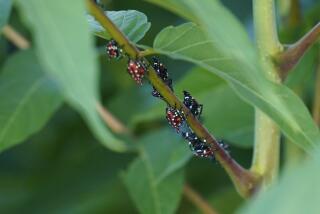MOORPARK : Schools Abuzz Over Yellow Jacket Plague
- Share via
Within the past month, nearly 50 students at Campus Canyon and Arroyo West elementary schools in Moorpark have been stung by carnivorous wasps.
The insects descend from nearby hills at lunchtime to buzz the outdoor eating area, dining on fruit cups and meat sandwiches.
“It’s one of those quirks of nature,” said Campus Canyon Principal Frank DePasquale. “I don’t know what’s bringing so many of them here, but they can sense the food.”
“They’re just everywhere,” said Nancy L. Lewis, a school office worker and a student at neighboring Moorpark College, which also has been plagued by the swarm. “It’s not as bad as the whitefly epidemic we had a few years ago, but they’ve become a nuisance.”
School officials have been urging parents not to dress their children in bright, floral-print clothing, which is almost as alluring to yellow jackets as pollen-laden flowers.
Kassidy Draper, 7, was stung on the neck last week while eating lunch.
“It hurt, but they put stuff on it to get all the germs out,” the second-grader said.
The preferred treatment, DePasquale said, is to put meat tenderizer and then an ice pack on the sting. Parents are notified immediately if there is any extensive or persistent swelling.
To combat the insect interlopers, school officials turned to the Moorpark Mosquito Abatement District, which has hung makeshift traps on playground fences that, so far, have had limited effect, DePasquale said.
The traps are little more than half-gallon bleach bottles containing a small piece of meat submerged in water, in which the wasps drown.
An alternative under consideration is to forgo the water and treat the meat with a chemical that the yellow jackets would take back to their nests to wipe out the colony.
Meanwhile, school officials are waiting for cooler weather, which usually grounds the aerial pests.
Some teachers have taken the occasion to offer lessons in entomology.
“There are 17,000 species of wasps in the world, 3,800 in the United States and Canada,” DePasquale said. “Male yellow jackets live two months, compared to up to a year for females. I know more about wasps than I ever cared to know.”
More to Read
Sign up for Essential California
The most important California stories and recommendations in your inbox every morning.
You may occasionally receive promotional content from the Los Angeles Times.













